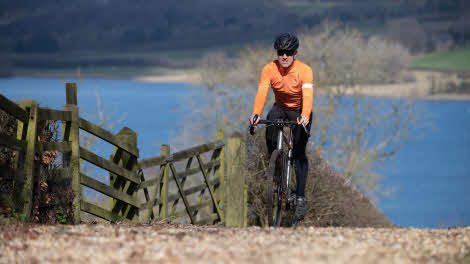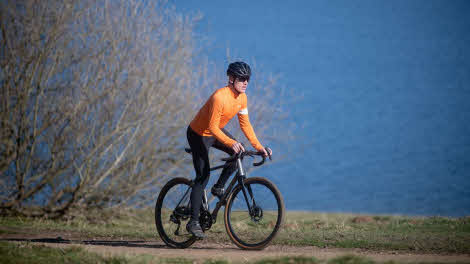Gravel biking in Rutland
Avid cyclist Jonathan Manning is always looking for new ways to sate his passion and his first impressions of gravel biking at Rutland Water proved a real eye-opener.

Regular readers will already know I am a keen cyclist (you can view my rides from Club sites on the Magazine App, as well as accompanying videos on youtube.com/CaravanandMotorhomeClub) so I was eager to try out an up-and-coming sport that has crossed the Atlantic – gravel riding.
Gravel riding harks back to an era before asphalt, when cycling involved pedalling along roads of hard-packed mud, cinder, pebbles and gravel. Perhaps surprisingly, around one third of US roads remain unpaved to this day. Rather than use heavy, cumbersome mountain bikes to trundle over such terrain, gravel riders take advantage of lighter, more agile machines that resemble road bikes but have a few key differences.
Featuring fatter tyres, a longer wheelbase and a relaxed geometry that creates a more upright, back-friendly riding position, a gravel bike is a go-anywhere machine for all-day adventures. It’s very much at home on asphalt but doesn’t bat an eyelid when the road comes to an end and the mud and gravel begin. Put succinctly, a gravel bike is a passport to explore old drovers’ tracks, forest trails and disused railway lines, as well as Britain’s brilliant bridleway network.
What really sets gravel riding apart from road cycling is the spirit of adventure that accompanies it. Suddenly dead ends vanish and rides don’t have to come to an abrupt stop when the asphalt finishes. Those enticing tracks that radiate from familiar roads become part of a spider’s web of possibilities – a gravel bike lets you scratch the itch of wonder at what lies beyond.
In fact it has become something of a mission for me during lockdown to add mind-clearing variety to rides from my front door. Rather than following the same old road loops, gravel riding has prompted me to mix and match roads with single-track and bridleway, to weave routes through woodland and even to roller-coaster in and out of a quarry. I’ve been snared by brambles, jolted by tree roots and soaked by puddles deeper than I had anticipated. And every time I’ve returned home with a huge grin stretched across my face.

If any ride showcases the versatility of a gravel bike, and the diversity of surfaces it
can sail over, it’s this route I picked around Rutland Water, the giant reservoir that lies within an easy pedal of Rutland Caravan and Camping Affiliated Site. Having borrowed a dreamy GRiT bike from Oakham-based titanium bike specialist J.Laverack Bicycles, I plotted a course that took me to Rutland Water almost as the crow flies – piecing together stretches of track and trail, and even crossing a ford, while relying on quiet roads as conjunctions between the off-road fun elements.
The real treat starts at the perimeter path around the reservoir where the surface changes rapidly from pavement to sheep track to flint-covered trail to hard-packed and soft-rutted mud, and even gravel. Happily the GRiT provides a sure-footed, magic carpet ride over this mixed terrain with the 43mm-wide tyres, almost twice as wide as standard road tyres, ensuring hovercraft-style cushioning over stones and pebbles.
The geometry of the bike distributes more of my weight over the rear wheel, enhancing traction, while a shorter stem lifts my weight off the handlebars for lighter, more responsive steering on technical trails. But that’s the science bit. For me, the real pleasure comes from riding at a brisk pace on tracks where I’d flinch to take a road bike but where a mountain bike with suspension would be overkill and slow. A gravel bike is a perfect blend of beef and efficiency, and a gateway to fresh adventures.
Three more gravel rides to try...
High Peak Trail: Follow a flat, easy to ride reclaimed railway line north through the Peak District. Later, the route continues as the seriously hilly Pennine Bridleway all the way to Cumbria.
Info: nationaltrail.co.uk
Stay: Carsington Water Club site
Scarborough to Whitby: Ride the old railway line between these two popular seaside resorts. It’s a fantastic, largely traffic-free experience with moorland and coastal views and brilliant visitor attractions at both ends.
Info: facebook.com/cindertrack
Stay: Cayton Village Club site
South Downs Way: Be prepared to tackle a few hills as you pedal the ancient chalk ridge from Winchester to Eastbourne, revelling in gorgeous country and coastal views. The 100-mile route includes 3,800m (12,600ft) of ascent, so allow two to three days to complete .
Info: nationaltrail.co.uk
Stay: Morn Hill Club site


